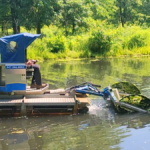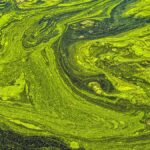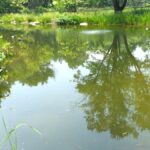Controlling algae and aquatic vegetation is often necessary to maintain a balance within a lake ecosystem. Timing herbicide treatments or mechanical harvesting to coincide with plant growth cycles maximizes effectiveness while minimizing impacts on desirable native plant species.
The key to algae management is to stay ahead of significant blooms. Early detection can occur by visual inspection or using newer technologies like sensor buoys that detect algae as it starts to grow. By treating the algae early, the issue is addressed before it grows out of control with the added benefit of using less product. On the other hand, if delaying treatment results in a bloom that takes over the lake, applications must be made in sections to prevent a dissolved oxygen crash related to the decomposition process. Not only does waiting require more chemicals, but it’s also hard to catch up and take control of the situation. In many cases, an aggressive algae bloom must be removed manually.
It is also important to know that algae species shift over the season, and new types may present themselves as the water temperature increases. These species tend to have a quicker rebound, so maintaining a regular treatment schedule for aggressive mid-season algae species is important.
Phosphorus is a critical nutrient for algae growth, and binding agents can be used to immobilize phosphorus in the water column, making it inaccessible to algae. This method, called nutrient deactivation, is an effective preventative measure to control algae. The protocol is to delay nutrient deactivation treatment until after a significant rain event since heavy rain will likely flush the lake ecosystem along with the product.
Early season aquatic plant management focuses on two main invasive plants – curly leaf pondweed and Eurasian water milfoil. Both plants can be treated in early spring using a systemic herbicide at very low doses. Since the plants are just starting to grow in early spring, the biomass of plant material is very low, requiring far less chemicals than when treating fully established plants. Like algae, when treated early, there is little decaying plant material and little opportunity for dissolved oxygen to crash, often leading to a fish-kill. Early spring treatments also preserve native plant species since these do not start growing until later in the season. These early spring treatments must be applied annually until the seed bank of the target plants has been exhausted.
Waiting to manage invasive aquatic plants until they fully mature requires pivoting the management approach. Switching to a contact herbicide will most likely be called for if treated chemically. These herbicides do not move to the roots like systemic herbicides and do not permanently kill the plant. Contact herbicides allow for a more targeted treatment of invasives while preserving native plant populations. Manual removal of mature plants using a harvester will provide some aesthetic relief but is not a long-lasting solution. Most harvesters act like lawnmowers that remove only the top portion of the plant, which grows back over time. Milfoil is also spread by fragmentation, which is why harvesting can sometimes worsen the problem. Diver Assisted Suction Harvesting, called DASH, operates by having divers remove the plant by the root and feed it into a suction hose for transport on to a boat. Fragments can be controlled using DASH, but the process of plant removal is slow. This process is best used for clearing around docks and swimming beaches.
Timing is also essential for treating invasive emergent plants like cattails and lilies. These plants take over shallow waters because of their robust rhizomatous root systems. It is necessary to wait to treat these plants after they flower, typically in late summer or early fall, when they actively translocate nutrients and chemicals to their roots for winter storage. This way, the herbicide is more likely to be absorbed into the roots, leading to better control.




